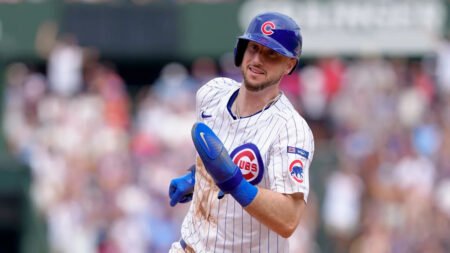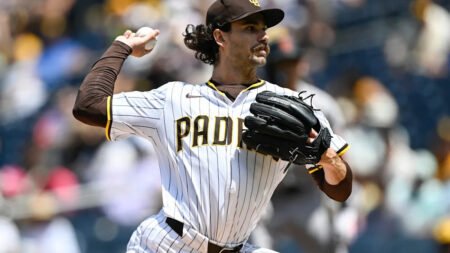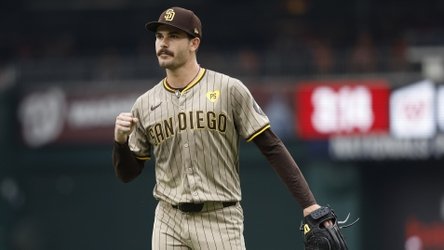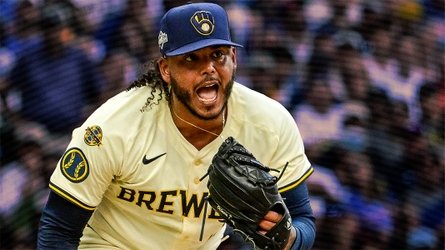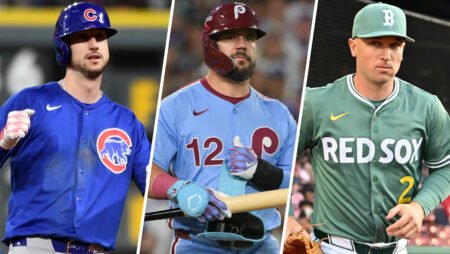Whichever team signs Bo Bichette this winter will be doing so in large part because of what he is capable of in the batter’s box. The son of 14-year major-leaguer and four-time All-Star Dante, Bo grew up around the game and blossomed into an elite amateur hitter as a prep player in Florida. Once a pro, Bichette quickly rose through the minor-league ranks with the Blue Jays and didn’t stop raking once he reached the big leagues, bursting on the scene with a .930 OPS in 46 games as a rookie in 2019 and making his first All-Star Game as a 23-year-old two years later.
With an unmistakable swing from the right side featuring a rhythmic leg kick and a distinct load with his hands, Bichette wields an unusual combination of bat-to-ball skills and impressive raw power, enabling the rare ability to slug consistently with low strikeout totals. Ignore his injury-riddled 2024, a glaring outlier, and Bichette’s offensive track record is impossible to deny: The dude just hits. In 2025, Bichette was firmly on track to lead the American League in hits for the third time in his career before he suffered a sprained left knee from a collision at home plate on Sept. 6. That injury cost Bichette the rest of the regular season and the first two rounds of the postseason, but it also set the stage for his heroic return to Toronto’s lineup in the World Series.
Advertisement
And during the epic seven-game Fall Classic against the Dodgers, Bichette reminded everyone why his bat has been revered for so long, admirably and impressively demonstrating that he can meaningfully impact the game even while playing in a compromised state. He collected hits in all six of his starts, a remarkable showing punctuated by a jaw-dropping, 441-foot blast off Shohei Ohtani in Game 7, a swing that will be remembered in Toronto for years to come, regardless of the series’ final result.
But while Bichette’s bat is unassailable, it’s his glove that could have a larger impact on how his free agency unfolds. His offense and rare youth for a free agent — he turns 28 in March — are the primary reasons he’ll command a nine-figure contract, but Bichette’s defense will dictate his role on his next roster, which in turn will significantly influence how many teams get involved in the bidding to sign him. Early reports indicate Bichette might not be viewed as a shortstop by all potential suitors, despite his playing the position almost exclusively as a big leaguer — and that actually might not be a bad thing for his market.
Before we look ahead, let’s review how Bichette, the defender, arrived at this pivotal juncture. It’s worth remembering that questions about Bichette’s glove date back nearly a decade to before he even entered pro ball. From Baseball America, which tabbed Bichette — a sweet-swinging infielder at Lakewood High School in St. Petersburg, Florida — as the 46th-best prospect in the 2016 MLB Draft:
Advertisement
“Bichette has a steady glove and a strong arm. He plays shortstop now and could go out as one, but will eventually move to second base or, more likely, owing to his 6-foot, 200-pound frame, third base. No matter where the Arizona State recruit ends up defensively, Bichette’s main attraction will always be his offensive ability.”
MLB Pipeline struck a similar tone, ranking him 90th in the class:
“A below-average runner, Bichette may continue to see time at shortstop, but, in the long run, he’s probably best suited defensively for second base, or perhaps even left field.”
Bichette’s selection — 66th overall by Toronto — split the difference between those two outlets’ rankings, but it didn’t take long for the player to separate himself as an upper-echelon prospect. Bichette hit .427/.451/.732 over his first 22 professional games in the Gulf Coast League as an 18-year-old, starting 16 games at shortstop and six at second base. As he climbed the minor-league ladder, his time at the keystone waned. Scouts continued to marvel at the bat while expressing skepticism about his glove, but Bichette kept playing shortstop.
For Toronto, it always made sense to let his special bat play at the premium position for as long as possible. And so, Bichette has stayed at short for essentially his entire career to this point. Advanced metrics such as Defensive Runs Saved and Outs Above Average have not been kind to his glovework, but he has passed the eye test just enough to stave off a shift to another spot, in turn enhancing his star power when factoring in his offensive output.
Advertisement
The 2025 season, however, marked a new low for Bichette’s defensive ratings, as he plummeted to last in both DRS and OAA among qualified shortstops. Meanwhile, offseason acquisition Andres Gimenez shined defensively at second base in Toronto, serving as quite the contrast. When Bichette went down with his knee injury, Gimenez and Ernie Clement filled in, with Gimenez taking the postseason reps at shortstop. That continued once Bichette returned for the World Series, with his limited mobility prompting Toronto to deploy him at second for the first time in his major-league career. He looked largely comfortable there, all things considered.
While Bichette’s World Series cameo at second was largely the product of circumstance, with free agency fast approaching, it sparked speculation about his ideal defensive fit moving forward, whether that be in Toronto alongside Gimenez or elsewhere. And now here we are, a decade after evaluators first forecast he’d need to move off shortstop, with Bichette finally facing the possibility of changing positions permanently.
That development could help maximize his market in free agency. Because for as good of a hitter as Bichette is, it’s difficult to identify a wealth of fits around the league if he’s viewed exclusively as a shortstop. In fact, based on the current projected shortstop depth charts at FanGraphs, arguably the only contending team with an indisputable hole at the position and a conceivable appetite to spend what it would take to land Bichette is the Braves.
Advertisement
Atlanta picked up Ha-Seong Kim off waivers in September, but Kim declined his $16 million player option to become a free agent. Nick Allen — a terrific defender whose 53 wRC+ ranked last among MLB hitters with 400 plate appearances in 2025 — was Atlanta’s starting shortstop before Kim’s brief cameo, but the Braves traded Allen to Houston earlier this month in exchange for utilityman Mauricio Dubon. Dubon could become the every-day shortstop and represent a modest upgrade, but if Atlanta wants to make a bigger splash, Bichette is an enticing fit. And if Ozzie Albies continues to decline sharply and is out of the picture after next season, second base could also open up for Bichette. All that said, Atlanta has lately been more active on the trade market and in extending its own players than spending big bucks in free agency, so this feels like a long shot.
Beyond the Braves, you have to squint to envision Bichette being a realistic target for the other clubs with clearly inferior options at shortstop, whether that’s based on spending habits (Brewers, Guardians, Pirates) or roster dynamics that portend a prioritization of resources elsewhere (Mets, Yankees, Mariners, Tigers).
But expand the search to include second base, and several more intriguing landing spots arise. Here’s a look at a handful of potential Bichette suitors based on the most inviting middle infield depth charts, beginning with the incumbent Blue Jays.
Toronto Blue Jays
Bichette has been adamant over the years and all the way through Toronto’s recent run to the World Series that he would love to remain a Blue Jay, and his outspoken desire to continue chasing a championship alongside Vladimir Guerrero Jr. has always come across as genuine. A pact to continue this highly productive player-team relationship would hardly be surprising if the two sides can find enough common ground to make a deal.
Advertisement
In this hypothetical, whether Bichette, once fully recuperated from his knee injury, would resume his duties at shortstop or move to second base in deference to Gimenez would be an interesting storyline to monitor. It’s very difficult to argue that Bichette is the superior shortstop defender at this point, but Toronto was willing to keep him there for this long, and perhaps Gimenez (owed roughly $86 million over the next four seasons) is more comfortable staying put at the position where he has won three Gold Gloves. Of course, however the defensive alignment shakes out, the most important aspect of a Bichette reunion would be his continued presence in the Blue Jays’ lineup and as one of the faces of the franchise alongside Guerrero.
Los Angeles Dodgers
Wouldn’t this be something? Mookie Betts might’ve been reborn as a plus defender at shortstop to address that position for the Dodgers, but second base remains something of an open question for the champs entering 2026. Maybe the versatile Tommy Edman settles in there. Perhaps they roll with a less proven but talented candidate such as Hyeseong Kim or Alex Freeland. Beloved veteran and Game 7 hero Miguel Rojas could also return.
But the reality is that none of those players is anywhere close to as good as Bo Bichette, meaning if the Dodgers want to max out their villain status this winter, they should chase Bichette to play second base. It’s possible, but L.A. spending big in the outfield and/or bullpen feels far more likely.
San Francisco Giants
The Giants have already invested heavily in their infield, signing third baseman Matt Chapman to a $151 million extension and shortstop Willy Adames to a $182 million free-agent deal and acquiring the roughly $250 million remaining on Rafael Devers’ contract, with the expectation that he’ll play first base moving forward.
Advertisement
Second base, however, is a massive weakness in San Francisco, with Giants second basemen combining for 73 wRC+ and 0.3 fWAR that ranked 27th in MLB in 2025 — and the same players (Casey Schmitt, Tyler Fitzgerald, Christian Koss) are still atop the depth chart as things stand. While pitching is reportedly more of a priority for San Francisco this winter, Bichette would fill a clear need as well.
Boston Red Sox
With Trevor Story opting in for another two years and $55 million, the Red Sox do not have a pressing need at shortstop, but second base is more uncertain. Ceddanne Rafaela just won a Gold Glove in the outfield, yet in an outfield that currently necessitates regular playing time for Roman Anthony, Jarren Duran and Wilyer Abreu, Rafaela’s clearest path to at-bats right now is amusingly not in center field but at second base, where he’s also a capable defender.
A trade of Duran — a highly possible path forward for Boston — would allow Rafaela to resume roaming center field regularly and leave second base wide open. Such a sequence could be sensible regardless of whether Bichette emerges as a Red Sox target. After all, it’s hard to envision any Bichette-to-Boston buzz taking precedence over the team’s goal of retaining Bregman to play third base. Should Bregman depart, however, Bichette stands out as an appealing pivot. Top prospect Marcelo Mayer, meanwhile, will likely play whichever infield spot is left unaddressed between second and third.
Advertisement
Philadelphia Phillies
As with Boston, a Philadelphia pursuit of Bichette would require some maneuvering, but such roster shuffling might be a worthwhile endeavor. It should be noted upfront that an upgrade in the outfield — and/or the Phillies doing whatever it takes to retain Kyle Schwarber at DH — is significantly more likely this winter than a dramatic shake-up in the infield.
That said, if those expected pursuits fall short — and if Alec Bohm stays put at third — Bichette could be an interesting, high-dollar target for Philadelphia if it’s willing to trade Bryson Stott to address other needs. Stott is a good player, an excellent defender and baserunner with solid on-base ability, but he isn’t a game-changing hitter of Bichette’s caliber. If the Phillies want to inject some new life into their lineup and aren’t able to do so through other avenues this winter, Bichette would unquestionably be an exciting, if unexpected, alternative.
Advertisement
Texas Rangers
Sure, the Rangers have some reasonable internal options (Josh Smith, Ezequiel Duran) to replace the recently traded Marcus Semien at second base, but what if Texas immediately reinvested some of the payroll it just slashed by throwing a boatload of cash at Bichette to join Corey Seager as a new dynamic duo up the middle?
We don’t yet have a sense for how much the Rangers are willing to spend their savings in the short term, but this would be a rather dramatic way for them to reassert themselves as relevant characters in the American League postseason picture.
Tampa Bay Rays
Before you dismiss the Rays as an option, recall that they surprisingly made a run at Freddie Freeman during his free agency, a reminder that basically any team can spend big if the right player motivates them to do so.
Advertisement
And let’s say the Rays finally trade Brandon Lowe and/or Yandy Diaz and want to build their next-generation infield around Junior Caminero and top shortstop prospect Carson Williams. In that case, Bichette — who played his high school ball a 10-minute drive from Tropicana Field — would represent an intriguing, rare, high-level expenditure for Tampa Bay to headline its lineup as a proven veteran presence.
On the subject of sentimentality, we could also mention the Rockies, considering Bichette’s father’s memorable stint in Denver, but now doesn’t seem like the right time for them to hand out another Kris Bryant-esque contract.
Read the full article here






